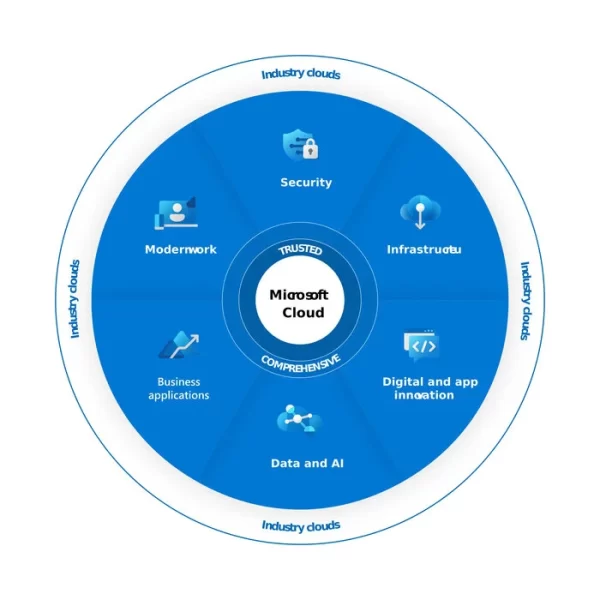Descripción del curso:
AI-102 Designing and Implementing an Azure AI Solution is intended for software developers wanting to build AI infused applications that leverage Azure Cognitive Services, Azure Cognitive Search, and Microsoft Bot Framework. The course will use C# or Python as the programming language.
Temas del curso
Module 1: Introduction to AI on Azure
Artificial Intelligence (AI) is increasingly at the core of modern apps and services. In this module, you’ll learn about some common AI capabilities that you can leverage in your apps, and how those capabilities are implemented in Microsoft Azure. You’ll also learn about some considerations for designing and implementing AI solutions responsibly.
Lecciones
- Introduction to Artificial Intelligence
- Artificial Intelligence in Azure
- Después de completar este módulo, los estudiantes podrán:
- Describe considerations for creating AI-enabled applications
- Identify Azure services for AI application development.
Module 2: Developing AI Apps with Cognitive Services
Cognitive Services are the core building blocks for integrating AI capabilities into your apps. In this module, you’ll learn how to provision, secure, monitor, and deploy cognitive services.
Lecciones
- Getting Started with Cognitive Services
- Using Cognitive Services for Enterprise Applications
- Después de completar este módulo, los estudiantes podrán:
- Provision and consume cognitive services in Azure
- Manage cognitive services security
- Monitor cognitive services
- Use a cognitive services container
Module 3: Getting Started with Natural Language Processing
Natural Language processing (NLP) is a branch of artificial intelligence that deals with extracting insights from written or spoken language. In this module, you’ll learn how to use cognitive services to analyze and translate text.
Lecciones
- Analyzing Text
- Translating Text
- Después de completar este módulo, los estudiantes podrán:
- Use the Text Analytics cognitive service to analyze text
- Use the Translator cognitive service to translate text
Module 4: Building Speech-Enabled Applications
Many modern apps and services accept spoken input and can respond by synthesizing text. In this module, you’ll continue your exploration of natural language processing capabilities by learning how to build speech-enabled applications.
Lecciones
- Speech Recognition and Synthesis
- Speech Translation
- Después de completar este módulo, los estudiantes podrán:
- Use the Speech cognitive service to recognize and synthesize speech
- Use the Speech cognitive service to translate speech
Module 5: Creating Language Understanding Solutions
To build an application that can intelligently understand and respond to natural language input, you must define and train a model for language understanding. In this module, you’ll learn how to use the Language Understanding service to create an app that can identify user intent from natural language input.
Lecciones
- Creating a Language Understanding App
- Publishing and Using a Language Understanding App
- Using Language Understanding with Speech
- Después de completar este módulo, los estudiantes podrán:
- Create a Language Understanding app
- Create a client application for Language Understanding
- Integrate Language Understanding and Speech
Module 6: Building a QnA Solution
One of the most common kinds of interaction between users and AI software agents is for users to submit questions in natural language, and for the AI agent to respond intelligently with an appropriate answer. In this module, you’ll explore how the QnA Maker service enables the development of this kind of solution.
Lecciones
- Creating a QnA Knowledge Base
- Publishing and Using a QnA Knowledge Base
- Después de completar este módulo, los estudiantes podrán:
- Use QnA Maker to create a knowledge base
- Use a QnA knowledge base in an app or bot
Module 7: Conversational AI and the Azure Bot Service
Bots are the basis for an increasingly common kind of AI application in which users engage in conversations with AI agents, often as they would with a human agent. In this module, you’ll explore the Microsoft Bot Framework and the Azure Bot Service, which together provide a platform for creating and delivering conversational experiences.
Lecciones
- Bot Basics
- Implementing a Conversational Bot
- Después de completar este módulo, los estudiantes podrán:
- Use the Bot Framework SDK to create a bot
- Use the Bot Framework Composer to create a bot
Module 8: Getting Started with Computer Vision
Computer vision is an area of artificial intelligence in which software applications interpret visual input from images or video. In this module, you’ll start your exploration of computer vision by learning how to use cognitive services to analyze images and video.
Lecciones
- Analyzing Images
- Analyzing Videos
- Después de completar este módulo, los estudiantes podrán:
- Use the Computer Vision service to analyze images
- Use Video Analyzer to analyze videos
Module 9: Developing Custom Vision Solutions
While there are many scenarios where pre-defined general computer vision capabilities can be useful, sometimes you need to train a custom model with your own visual data. In this module, you’ll explore the Custom Vision service, and how to use it to create custom image classification and object detection models.
Lecciones
- Image Classification
- Object Detection
- Después de completar este módulo, los estudiantes podrán:
- Use the Custom Vision service to implement image classification
- Use the Custom Vision service to implement object detection
Module 10: Detecting, Analyzing, and Recognizing Faces
Facial detection, analysis, and recognition are common computer vision scenarios. In this module, you’ll explore the user of cognitive services to identify human faces.
Lecciones
- Detecting Faces with the Computer Vision Service
- Using the Face Service
- Después de completar este módulo, los estudiantes podrán:
- Detect faces with the Computer Vision service
- Detect, analyze, and recognize faces with the Face service
Module 11: Reading Text in Images and Documents
Optical character recognition (OCR) is another common computer vision scenario, in which software extracts text from images or documents. In this module, you’ll explore cognitive services that can be used to detect and read text in images, documents, and forms.
Lecciones
- Reading text with the Computer Vision Service
- Extracting Information from Forms with the Form Recognizer service
- Después de completar este módulo, los estudiantes podrán:
- Use the Computer Vision service to read text in images and documents
- Use the Form Recognizer service to extract data from digital forms
Module 12: Creating a Knowledge Mining Solution
Ultimately, many AI scenarios involve intelligently searching for information based on user queries. AI-powered knowledge mining is an increasingly important way to build intelligent search solutions that use AI to extract insights from large repositories of digital data and enable users to find and analyze those insights.
Lecciones
- Implementing an Intelligent Search Solution
- Developing Custom Skills for an Enrichment Pipeline
- Creating a Knowledge Store
- Después de completar este módulo, los estudiantes podrán:
- Create an intelligent search solution with Azure Cognitive Search
- Implement a custom skill in an Azure Cognitive Search enrichment pipeline
- Use Azure Cognitive Search to create a knowledge store
Habilidades adquiridas
Los estudiantes aprenderán a,
- Describe considerations for AI-enabled application development
- Create, configure, deploy, and secure Azure Cognitive Services
- Develop applications that analyze text
- Develop speech-enabled applications
- Create applications with natural language understanding capabilities
- Create QnA applications
- Create conversational solutions with bots
- Use computer vision services to analyze images and videos
- Create custom computer vision models
- Develop applications that detect, analyze, and recognize faces
- Develop applications that read and process text in images and documents
- Create intelligent search solutions for knowledge mining.
Público objetivo
Software engineers concerned with building, managing and deploying AI solutions that leverage Azure Cognitive Services, Azure Cognitive Search, and Microsoft Bot Framework. They are familiar with C# or Python and have knowledge on using REST-based APIs to build computer vision, language analysis, knowledge mining, intelligent search, and conversational AI solutions on Azure.
Inclusiones
Con CCS Learning Academy, recibirás:
- Formación dirigida por un instructor certificado
- Colaboración con compañeros de clase (actualmente no disponible para cursos a su propio ritmo)
- Escenarios y actividades de aprendizaje del mundo real.
- Soporte para la programación de exámenes*
- Disfrute de asistencia para la colocación laboral durante los primeros 12 meses después de finalizar el curso.
- Este curso es elegible para el programa Learn and Earn de CCS Learning Academy: obtenga un reembolso de la matrícula de hasta 50% si se le coloca en un trabajo a través de CCS Global Tech. División de colocación*
- Precios gubernamentales y privados disponibles.*
*Para más detalles llame al: 858-208-4141 o correo electrónico: formación@ccslearningacademy.com; ventas@ccslearningacademy.com






